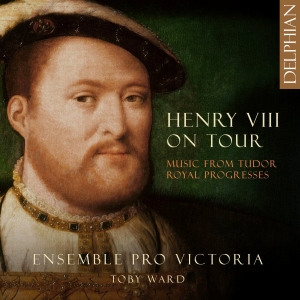
Henry VIII On Tour
Music from Tudor Royal Progresses
David de Winter (tenor)
Toby Carr (lute), Aileen Henry (harp), Magnus Williamson (organ) New Vocal Ensemble
Ensemble Pro Victoria/Toby Ward
rec. 2024, St. Nicholas Church, Newcastle, UK (organ music), St. Nicholas Church, Lyddington, UK (other works)
Delphian DCD34335 [63]
Henry VIII enjoyed travelling around his kingdom, staying with other members of the aristocracy but also in his many palaces. Wherever he went, often also did his singers, instrumentalists and keyboard players. This disc reflects that period. It introduces us to several early Tudor musicians who are not only new to someone like me but also new to the catalogue.
But why has the disc mainly been recorded in that most beguiling of Rutland churches at Lyddington? Next to it sits a so-called Bede House, built probably in the 14th century as a bishop’s palace. Henry passed through the village on his journeys north to York, and very likely stayed there, no doubt attending a Mass in the fine, well-proportioned church. There are many possible Masses that might have been heard at Lyddington, and indeed they may have been largely plainchant. Here we have one by the otherwise unknown William Rasar. Its style, quite complex contrapuntally, would have needed Henry’s better singers.
As far as domestic music-making is concerned, we do not really know for sure what was heard, or the sort of musician involved. Henry himself seems to have been a versatile instrumentalist, very enthusiastic especially in his early years. There are, though, various songbooks containing three- and four-part secular works by composers like William Cornysh. He is represented here by two pieces, including the little-known Ah, the sighs.
The programme is a cross-section of all of these things. Organist Magnus Williamson’s wonderfully extensive booklet essay goes into much detail about the background to Henry’s world, and about the composers who were part of the significant music-making at his court, even if only briefly. One of them was the virtuoso organist at St. Paul’s, John Redford.
Two choirs perform on the recording. The Ensemble Pro Victoria (pictured outside Lyddington Church), and the New Vocal Ensemble combine to sing William Rasar’s Missa Christe Jesu; its technique points the way to Taverner and Fayrfax. He may have composed it around 1510, when he was a lay clerk in Cambridge. Now, it may be the intimate church acoustic and the fact that this young and enthusiastic choir consists of twelve forthright singers, but the sound is very strong and immediate; you may want to turn the volume down. I like the almost in-your-face sound but arguably it is not always subtle enough for some of the more reflective sections of the mass. (Their 2021 Fayrfax recording on Delphian DCD34265, in a different acoustic, is free of this problem.)
The New Vocal Ensemble has three voices each of soprano, alto and bass. They sound gentler and mostly well-balanced. Their repertoire includes works by continental composers. Yes, King Henry knew many of the better works coming from ‘foreign’ parts. Some are even to be found in the various songbooks of the time, like the Newbery-Oscott part books which, for example, has Philippe Verdelot’s moving Sancta Maria Virgo virginum.
The instrumental pieces include three numbers deliciously played by harpist Aileen Henry. Interestingly, it seems that the harp was fading out of fashion during Henry’s reign in favour of the lute, which after all, amongst the other benefits, can play chromatically. We hear some Galliards by a certain John White played on the organ. He was headmaster of Winchester College and then bishop of that see in the 1550s. The lute is played in two secular songs, including Henry’s own En vray amoure.
The disc ends with a glowing performance of Adivi vocem de caelo, a responsory for All Saints’ tide, by John Taverner, the greatest Tudor composer with close connections to the king. The work can be thought of as summing up the end of the Henrician age and marking the eve of the reformation.
All texts are provided, with Henry Howard’s meticulous translations.
Gary Higginson
Contents
William Cornysh (1465-1523)
Ah, the sighs
Trolly, lolly
Anonymous
A galyard (lute solo)
William Rasar (fl.c.1515)
Missa Christi Jesu
Gloria
Credo
Sanctus
John Redford (c.1500-1547)
Felix Namque I
William Rasar
Missa Christe Jesu
Benedictus
Agnus dei
Anonymous (c.1540)
Beata Viscera
Dionisius Prioris (c.1514)
Dulcis amica Dei
Philippe Verdelot (c.1500-c.1530)
Sancta Maria virgo virginum
Anonymous (c.1520)
The Kynges maske
John Redford
Felix Namque II
Philip van Wilder (c.1500-1554)
Sancte Deus
John White (1509-1560)
Galliards 1, 2 and 3
William More (d.1565)
Levevi oculos meus
Robert Cowper (d.1539/1540)
Fare well my joy
Henry VIII (1491-1547)
En vray amours
John Taverner (c.1490-1545)
Audivi vocem de caelo


















